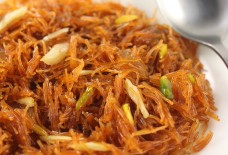More than 2,500 celebrate ArabFest at Headwaters
If you have a craving for Middle Eastern food these days, you pretty much have to go to Dearborn, Michigan to get it.
But this weekend, you could have satisfied that craving at the first-ever ArabFest held in the West Pavilion at Headwaters Park on Saturday and Sunday. More than 2,500 people stood in long lines to feast on shawarma, tabbouleh, hummus and baba ganoush served on pita-style bread and to get a taste of Middle Eastern culture. Middle Eastern music filled the air while large flags flew for every one of the 22 Arab countries.
The lines were nearly as long when on Sunday camel rides were offered around a small ring. Sabah Husain said her 5-year-old son, Yaeshawn, was so excited when he got to ride on the camel that “his face just lit up.” Not one to talk, he just shook with delight, she said.
Sam Jarjour, a Fort Wayne resident whose parents came from Syria and a director with the Indiana Center for Middle East Peace, the event’s sponsor, said as a cultural event, ArabFest was long overdue. That said, it was also a lot of work as he oversaw the food preparation and serving.
Arab Americans like Jarjour number at least 1,000 in the city, but that number is “greatly underestimated,” he said, and only represents the number of Arabs who identified themselves as such for the U.S. Census.
In Dearborn, Michigan, Arab Americans and people of Arab descent are estimated to make up about 40 percent of the population. Assam Dannaoui, originally from Lebanon, and his wife, Judy of Fort Wayne regularly trek to Dearborn for the great food, they said, and came to the ArabFest just to check it out. They were standing in line so Judy could get her hand painted with henna by local henna artist, Rachel Mitchell.
Mitchell describes her typical designs as non-traditional, “but given the venue, I’m trying to keep it pretty traditional.” The popular complicated drawings often have a floral motif as well as dots and paisley-like symbols drawn with an ink that lasts about two weeks, Mitchell said.
No one is sure where henna originated, but it is popular in the Arab world. “It binds us together just like dance,” said Mitchell who studies Middle Eastern or belly dance as well. Agreeing with her was her belly dance teacher, Amanda Bohnke-Lyon, also there to take in the atmosphere with her husband, Jason Lyon.
Jarjour said that next year the event will likely invite local Middle Eastern dancers to perform. There was a stage set up for debka dancers, a typical dance that everyone learns how to do in the Middle East, said one onlooker who did not want to give his name.
Bohnke and the Dannaouis looked on as Mitchell worked on Christine Newman-Aumiller, a Fort Wayne resident. “I’m glad we have this many people out for this type of event,” Newman-Aumiller said. “Fort Wayne has the reputation as a conservative city, but in a lot of ways we’re very tolerant.
“We support the Arab culture.” No one has “the right to think because a person is Arab he is any different than anyone else,” Newman-Aumiller said.
Turnout for the event “far exceeded our expectations,” said Michael Spath, executive director for the Indiana Center for Middle East Peace.
Source: www.journalgazette.net



